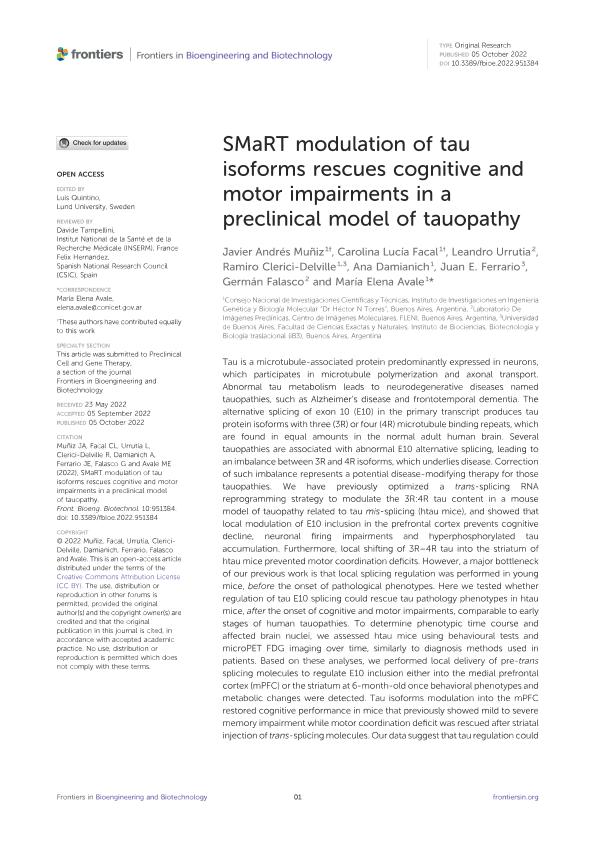Mostrar el registro sencillo del ítem
dc.contributor.author
Muñiz, Javier Andrés

dc.contributor.author
Facal, Carolina Lucia

dc.contributor.author
Urrutia, Leandro

dc.contributor.author
Clerici Delville, Ramiro

dc.contributor.author
Damianich, Ana

dc.contributor.author
Ferrario, Juan Esteban

dc.contributor.author
Falasco, Germán Alfredo

dc.contributor.author
Avale, Maria Elena

dc.date.available
2023-10-26T17:46:55Z
dc.date.issued
2022-10
dc.identifier.citation
Muñiz, Javier Andrés; Facal, Carolina Lucia; Urrutia, Leandro; Clerici Delville, Ramiro; Damianich, Ana; et al.; SMaRT modulation of tau isoforms rescues cognitive and motor impairments in a preclinical model of tauopathy; Frontiers Media; Frontiers in Bioengineering and Biotechnology; 10; 10-2022; 1-13
dc.identifier.issn
2296-4185
dc.identifier.uri
http://hdl.handle.net/11336/216095
dc.description.abstract
Tau is a microtubule-associated protein predominantly expressed in neurons, which participates in microtubule polymerization and axonal transport. Abnormal tau metabolism leads to neurodegenerative diseases named tauopathies, such as Alzheimer’s disease and frontotemporal dementia. The alternative splicing of exon 10 (E10) in the primary transcript produces tau protein isoforms with three (3R) or four (4R) microtubule binding repeats, which are found in equal amounts in the normal adult human brain. Several tauopathies are associated with abnormal E10 alternative splicing, leading to an imbalance between 3R and 4R isoforms, which underlies disease. Correction of such imbalance represents a potential disease-modifying therapy for those tauopathies. We have previously optimized a trans-splicing RNA reprogramming strategy to modulate the 3R:4R tau content in a mouse model of tauopathy related to tau mis-splicing (htau mice), and showed that local modulation of E10 inclusion in the prefrontal cortex prevents cognitive decline, neuronal firing impairments and hyperphosphorylated tau accumulation. Furthermore, local shifting of 3R–4R tau into the striatum of htau mice prevented motor coordination deficits. However, a major bottleneck of our previous work is that local splicing regulation was performed in young mice, before the onset of pathological phenotypes. Here we tested whether regulation of tau E10 splicing could rescue tau pathology phenotypes in htau mice, after the onset of cognitive and motor impairments, comparable to early stages of human tauopathies. To determine phenotypic time course and affected brain nuclei, we assessed htau mice using behavioural tests and microPET FDG imaging over time, similarly to diagnosis methods used in patients. Based on these analyses, we performed local delivery of pre-trans splicing molecules to regulate E10 inclusion either into the medial prefrontal cortex (mPFC) or the striatum at 6-month-old once behavioral phenotypes and metabolic changes were detected. Tau isoforms modulation into the mPFC restored cognitive performance in mice that previously showed mild to severe memory impairment while motor coordination deficit was rescued after striatal injection of trans-splicing molecules. Our data suggest that tau regulation could recover pathological phenotypes early after phenotypic onset, raising promising perspectives for the use of RNA based therapies in tauopathies related to MAPT abnormal splicing.
dc.format
application/pdf
dc.language.iso
eng
dc.publisher
Frontiers Media

dc.rights
info:eu-repo/semantics/openAccess
dc.rights.uri
https://creativecommons.org/licenses/by-nc-sa/2.5/ar/
dc.subject
DEMENTIA
dc.subject
FDG-MICROPET
dc.subject
MAPT
dc.subject
RNA THERAPY
dc.subject
TRANS-SPLICING
dc.subject.classification
Tecnologías que involucran la identificación de ADN, proteínas y enzimas, y cómo influyen en el conjunto de enfermedades y mantenimiento del bienestar

dc.subject.classification
Biotecnología de la Salud

dc.subject.classification
CIENCIAS MÉDICAS Y DE LA SALUD

dc.title
SMaRT modulation of tau isoforms rescues cognitive and motor impairments in a preclinical model of tauopathy
dc.type
info:eu-repo/semantics/article
dc.type
info:ar-repo/semantics/artículo
dc.type
info:eu-repo/semantics/publishedVersion
dc.date.updated
2023-10-25T10:06:58Z
dc.journal.volume
10
dc.journal.pagination
1-13
dc.journal.pais
Suiza

dc.description.fil
Fil: Muñiz, Javier Andrés. Consejo Nacional de Investigaciones Científicas y Técnicas. Instituto de Investigaciones en Ingeniería Genética y Biología Molecular "Dr. Héctor N. Torres"; Argentina
dc.description.fil
Fil: Facal, Carolina Lucia. Consejo Nacional de Investigaciones Científicas y Técnicas. Instituto de Investigaciones en Ingeniería Genética y Biología Molecular "Dr. Héctor N. Torres"; Argentina
dc.description.fil
Fil: Urrutia, Leandro. Fundación para la Lucha contra las Enfermedades Neurológicas de la Infancia; Argentina
dc.description.fil
Fil: Clerici Delville, Ramiro. Consejo Nacional de Investigaciones Científicas y Técnicas. Instituto de Investigaciones en Ingeniería Genética y Biología Molecular "Dr. Héctor N. Torres"; Argentina. Universidad de Buenos Aires. Facultad de Ciencias Exactas y Naturales. Instituto de Biociencias, Biotecnología y Biología Traslacional; Argentina
dc.description.fil
Fil: Damianich, Ana. Consejo Nacional de Investigaciones Científicas y Técnicas. Instituto de Investigaciones en Ingeniería Genética y Biología Molecular "Dr. Héctor N. Torres"; Argentina
dc.description.fil
Fil: Ferrario, Juan Esteban. Universidad de Buenos Aires. Facultad de Ciencias Exactas y Naturales. Instituto de Biociencias, Biotecnología y Biología Traslacional; Argentina. Consejo Nacional de Investigaciones Científicas y Técnicas; Argentina
dc.description.fil
Fil: Falasco, Germán Alfredo. Fundación para la Lucha contra las Enfermedades Neurológicas de la Infancia; Argentina
dc.description.fil
Fil: Avale, Maria Elena. Consejo Nacional de Investigaciones Científicas y Técnicas. Instituto de Investigaciones en Ingeniería Genética y Biología Molecular "Dr. Héctor N. Torres"; Argentina
dc.journal.title
Frontiers in Bioengineering and Biotechnology
dc.relation.alternativeid
info:eu-repo/semantics/altIdentifier/url/https://www.frontiersin.org/articles/10.3389/fbioe.2022.951384/full
dc.relation.alternativeid
info:eu-repo/semantics/altIdentifier/doi/http://dx.doi.org/10.3389/fbioe.2022.951384
Archivos asociados
